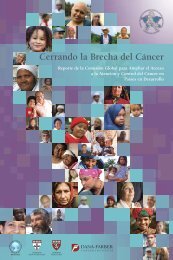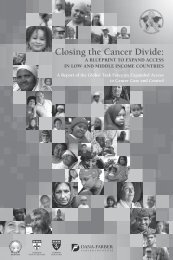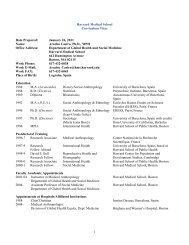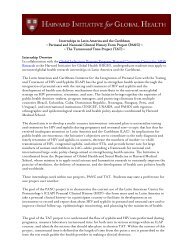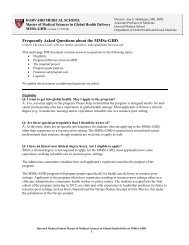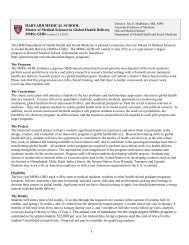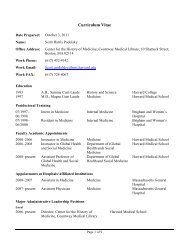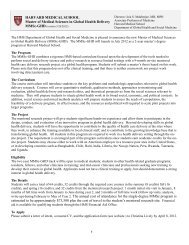Haiti Case Study - The Department of Global Health and Social ...
Haiti Case Study - The Department of Global Health and Social ...
Haiti Case Study - The Department of Global Health and Social ...
Create successful ePaper yourself
Turn your PDF publications into a flip-book with our unique Google optimized e-Paper software.
<strong>Haiti</strong>ans continued working in the public sector, a significant loss <strong>of</strong> staff did occur in the<br />
public sector through the hiring <strong>of</strong> staff by foreign response organizations, a practice referred<br />
to as “poaching” which, combined with emigration <strong>of</strong> <strong>Haiti</strong>an doctors <strong>and</strong> nurses, continues to<br />
contribute to a shortage <strong>of</strong> indigenous health pr<strong>of</strong>essionals.<br />
50. Communication systems which might ordinarily enable the healthcare system to<br />
coordinate patient triage <strong>and</strong> transfers were also not functional: l<strong>and</strong>lines were inoperable<br />
(for weeks, ultimately); all three principal cell phone networks were down or overloaded;<br />
internet connections, which would rely on both electricity <strong>and</strong> a functioning infrastructure,<br />
were inoperable (except for satellite dish-served users who had residual power). 48<br />
51. <strong>The</strong> PROMESS warehouse fortunately had been restocked in the months before the<br />
earthquake <strong>and</strong> it sustained little structural damage. However, the roads <strong>and</strong><br />
communications to the warehouse were disrupted or damaged. Also, the warehouse was<br />
unprepared to deal with the massive influx <strong>of</strong> medical aid supplies channelled through it<br />
during the earthquake response.<br />
52. With respect to health system financing, while care was provided without charge for the<br />
first few months after the earthquake, little reform <strong>of</strong> the health payment arrangements has<br />
taken place since then. <strong>The</strong> World Bank assumed the role <strong>of</strong> fiscal agent for the <strong>Haiti</strong>an<br />
government <strong>and</strong> temporarily took over payroll functions for federal employees. 49 However,<br />
sustained donor funding for direct budget support has been difficult to maintain. Several<br />
unique arrangements to fund the salaries <strong>of</strong> public sector health employees materialized<br />
including one scheme whereby the American Red Cross temporarily paid the salaries <strong>of</strong><br />
<strong>Haiti</strong>an public health sector employees. This process was fraught with administrative <strong>and</strong><br />
bureaucratic difficulties. 50<br />
53. <strong>The</strong> subsequent cholera epidemic did not in itself massively degrade the health<br />
system, but it showed that the health system strengthening following the earthquake had not<br />
reached a stage where the health system could cope with a threat <strong>of</strong> such magnitude.<br />
54. In order to summarize the changes the disasters' caused to the state <strong>of</strong> the <strong>Haiti</strong>an<br />
national health system, we used the WHO <strong>Health</strong> System Building Blocks Framework as<br />
depicted in the following table.<br />
Table 2: Summary <strong>of</strong> impacts to <strong>Haiti</strong>an national health system<br />
WHO Framework<br />
Component<br />
Service Delivery<br />
(Infrastructure)<br />
Before After<br />
Perhaps the most significant dynamic<br />
in <strong>Haiti</strong>’s health sector—one typical in<br />
fragile states—was the leadership’s<br />
limited influence over the planning<br />
<strong>and</strong> activities <strong>of</strong> the health sector<br />
relative to numerous foreign actors,<br />
including NGOs that provide about<br />
35% <strong>of</strong> the health services in the<br />
country.<br />
12<br />
60% <strong>of</strong> the hospitals were severely<br />
damaged or destroyed, including<br />
the only national teaching <strong>and</strong><br />
reference (tertiary) hospital.<br />
<strong>The</strong> international responders<br />
brought a wide spectrum <strong>of</strong> care:<br />
primary (most <strong>of</strong> the providers),<br />
secondary <strong>and</strong> very little tertiary<br />
care. This surge <strong>of</strong> care capability<br />
was limited to the disaster<br />
response. <strong>The</strong>re is progress in<br />
restoring <strong>and</strong> developing health<br />
service delivery but basic health<br />
needs remain unfulfilled.



